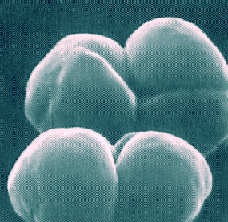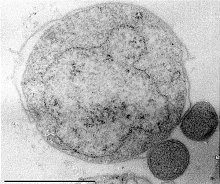Chrysiogenaceae is a family of bacteria.
The Thermoprotei is a class of the Thermoproteota.

The Hyphomicrobiales are an order of Gram-negative Alphaproteobacteria.
In taxonomy, the Methanopyri are a class of the Euryarchaeota.

In taxonomy, the Thermoplasmata are a class of the Euryarchaeota.

In taxonomy, the Thermoplasmatales are an order of the Thermoplasmata. All are acidophiles, growing optimally at pH below 2. Picrophilus is currently the most acidophilic of all known organisms, being capable of growing at a pH of -0.06. Many of these organisms do not contain a cell wall, although this is not true in the case of Picrophilus. Most members of the Thermotoplasmata are thermophilic.

In the taxonomy of microorganisms, the Methanomicrobia are a class of the Euryarchaeota.

Methanococci is a class of methanogenic archaea in the phylum Euryarchaeota. They can be mesophilic, thermophilic or hyperthermophilic.

The Desulfurococcales is an order of the Thermoprotei, part of the kingdom Archaea. The order encompasses some genera which are all thermophilic, autotrophs which utilise chemical energy, typically by reducing sulfur compounds using hydrogen. Desulfurococcales cells are either regular or irregular coccus in shape, with forms of either discs or dishes. These cells can be single, in pairs, in short chains, or in aciniform formation.
Methanobacteriales is an order of archaeans in the class Methanobacteria. Species within this order differ from other methanogens in that they can use fewer catabolic substrates and have distinct morphological characteristics, lipid compositions, and RNA sequences. Their cell walls are composed of pseudomurein. Most species are Gram-positive with rod-shaped bodies and some can form long filaments. Most of them use formate to reduce carbon dioxide, but those of the genus Methanosphaera use hydrogen to reduce methanol to methane.
In taxonomy, the Methanosaetaceae are a family of microbes within the order Methanosarcinales. All species within this family use acetate as their sole source of energy.

Bacteroidales is an order of bacteria. Notably it includes the genera Prevotella and Bacteroides, which are commonly found in the human gut microbiota.

The order Flavobacteriales comprises several families of environmental bacteria.
The Sphingobacteriales is an order of environmental bacteria.
Methanocaldococcus formerly known as Methanococcus is a genus of coccoid methanogen archaea. They are all mesophiles, except the thermophilic M. thermolithotrophicus and the hyperthermophilic M. jannaschii. The latter was discovered at the base of a “white smoker” chimney at 21°N on the East Pacific Rise and it was the first archaean genome to be completely sequenced, revealing many novel and eukaryote-like elements.
In taxonomy, Methanotorris is a genus of the Methanocaldococcaceae. The organisms in this genus differ from those of Methanothermococcus in that they are hyperthermophiles and from those of Methanocaldococcus in that they have no flagella, are not motile, and do not require selenium to grow. These microbes have not been shown to cause any illnesses.

The Acidobacteriaceae are a family of Acidobacteriota.
Mycoplasmatota is a phylum of bacteria that contains the class Mollicutes. The phylum was originally named "Tenericutes". Notable genera include Mycoplasma, Spiroplasma, Ureaplasma, and Candidatus Phytoplasma.
Bergey's Manual of Systematic Bacteriology is the main resource for determining the identity of prokaryotic organisms, emphasizing bacterial species, using every characterizing aspect.
The Marinilabiliaceae are a family of bacteria.






